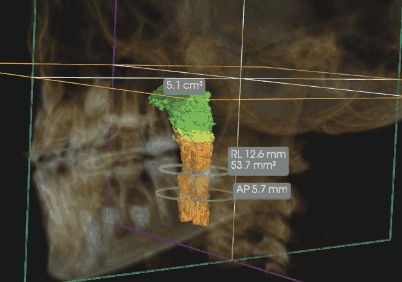Editor’s intro: In this article, Dr. Robert “Tito” Norris shows that orthodontists who adopt the latest knowledge and technology are helping patients breathe, sleep, and focus better.
Dr. Robert “Tito” Norris discusses Carestream Dental’s 3D modules and systems
Everyone knows what orthodontists do: braces. From a patient’s perspective, orthodontists simply straighten teeth, and that’s it. But if they only knew what orthodontists could do for them thanks to advancements in digital technology such as cone beam computed tomography. While admittedly clear aligners are making the image of brackets slowly fade in patients’ minds, straightening teeth in general is just the tip of the iceberg of what CBCT allows orthodontists to do for their patients.
Airway visualization


I’ve been looking at airways for about the past 15 years, trying to educate and elicit the support of local ENTs to assist in opening airways constricted by tonsils, adenoids, polyps, swollen turbinates, deviated septa, and enlarged tongues. We’ve known since the 1960s that expanding the maxilla can increase nasal air volume significantly. Airway has gained national attention in orthodontics over the past 5 years as a movement of “airway-friendly” orthodontics has emerged. In fact, the entire 2019 AAO Winter Conference lecture series revolved around the topic.
Though these concepts are still relatively new within the specialty, orthodontists play a critical role in recognizing signs of airway problems, and patients are frequently surprised when an orthodontist recognizes an airway issue that has been missed by multiple physicians over the patient’s lifetime, often with significant sequelae. In addition to large tonsils, narrow palates, open bites, tethered tongues, anterior spacing, dento-alveolar extrusion, high mandibular plane angles, short upper lips, anterior tooth wear, and narrow nares — just to name a few — orthodontists now have the ability to send patients off with a home sleep study and utilize important visualization tools such as the CS Airway module (Carestream Dental) to quantify the minimum axial airway area (Figure 3B).
These two tools have been critical in getting patients to actually go to the ENT specialist for evaluation. The CS Airway module alone is used in my practice multiple times a day to quickly analyze the airway in 3D. The color coding of the pharyngeal region highlights constrictions, so I can effectively communicate concerns with patients. As a specialty, orthodontists must continue to take the lead in this area because constricted airways are simply not on the radar for most physicians, and patients are suffering because of it.

Micro-implant assisted rapid palatal expansion (MARPE)
Though this technique has a history of inconsistent results and significant morbidity, in the past couple of years, these issues have been resolved, and it has now become an effective and predictable method to get true parallel (not trapezoidal) skeletal expansion in all teens and even most adult females. We’ve been using the MARPE technique that was developed at UCLA for over a year now with amazing success.
Having a CBCT in-house (CS 9300 system, Carestream Dental) is critical to the success of the technique because the micro-implant placement must be extremely accurate, and bicortical engagement of the micro-implants must be verified via CBCT before the patient can begin expansion (Figure 4). Using MARPE, we have been able to increase nasal airway volumes; increase oral cavity volumes to improve tongue posture; and develop maxillae not only laterally, but also anteriorly via a facemask therapy or mandiublar Bollard plates applied to a skeletally anchored maxillary expansion appliance, which has just loosened all five maxillary sutures.
As more orthodontists adopt in-house CBCT systems, the MARPE technique will spread in orthodontics, giving clinicians the ability to solve a number of complaints for their patients
TMJ discomfort
Most orthodontists have some basic understanding of TMJ but many are simply too busy straightening teeth to deal with it. Imaging of the joint with a CBCT system plays an important role in properly managing these patients. With a large FOV CBCT system like the CS 9300, orthodontists are able to offer an interdisciplinary solution for patients in TMJ discomfort.
Dentofacial orthopedics

It’s time that we started living up to our name as specialists in orthodontics and dentofacial orthopedics. By using the latest knowledge and technology, we have the ability to help patients breathe, sleep, and focus better. We can help alleviate the suffering of most TMJ patients as well. Spread the word — let your patients know you invested in them by investing in advanced technology. Let referrals know that they can send their patients to you for 3D scans rather than an imaging center (especially helpful for doctors practicing in rural areas). Let everyone know that orthodontics is so much more than straight teeth; it’s life changing.

For more about the latest knowledge and technology for orthodontists, check out “Carestream Dental and the Orthodontic Solution” here.
- Kumar SA, Gurunathan D, Muruganandam E, Sharma S. Rapid Maxillary Expansion: A Unique Treatment Modality in Dentistry. Journal of Clinical and Diagnostic Research. 2011;5(4) 906-911.
Stay Relevant With Orthodontic Practice US
Join our email list for CE courses and webinars, articles and mores


